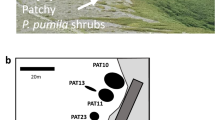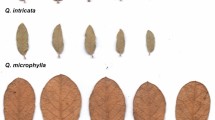Abstract
Human activities can promote increased hybridization in the genus Eucalyptus with potentially detrimental consequences for the persistence of rare species. However, many hybrid combinations have not been investigated with combined use of genetic markers and morphology. We assessed the efficiency of the STRUCTURE program and morphological intermediacy for identifying hybrids between the uncommon tree, Eucalyptus aggregata, which putatively hybridizes with the common congeners, E. rubida and E. viminalis in south-eastern Australia. We sampled 1,005 seedlings across 27 populations, all seedlings were genotyped at 6 allozyme loci and scored for 22 stem and leaf characters. Both marker sets confirmed that E. aggregata is hybridizing with both E. rubida and E. viminalis. Allozymes revealed hybrids from E. aggregata trees in 88% of populations and hybrids comprised 7.3% of all seedlings. Both genetics and morphology indicated that ~50% were likely to be F1 hybrids, and both simulations and morphological characteristics indicated that the remainder were mostly backcrosses. Morphological analysis correctly distinguished 71% of F1 hybrids from parentals and was least accurate when dealing with potential backcrosses (50% success). Hence, techniques using genetic data (no prior information) and the assessment of appropriate admixture thresholds through simulations provided the most accurate estimates of hybrid frequency. In this study, potential introgression and the high frequency of hybrids in small populations (~30%), suggests that hybridization should be considered in the management and conservation of E. aggregata.




Similar content being viewed by others
References
Abbott R, James J, Milne R, Gillies A (2003) Plant introductions, hybridization and gene flow. Philos Trans R Soc Lond B Biol Sci 358:1123–1132. doi:10.1098/rstb.2003.1289
Anderson EC, Thompson EA (2002) A model-based method for identifying species hybrids using multilocus genetic data. Genetics 160:1217–1229
Arnold ML (1997) Natural hybridization and evolution. Oxford University Press, Oxford
Barbour RC, Potts BM, Vaillancourt RE, Tibbits WN, Wiltshire RJE (2002) Gene flow between introduced and native Eucalyptus species. New For 23:177–191. doi:10.1023/A:1020389432492
Barbour RC, Potts BM, Vaillancourt RE (2003) Gene flow between introduced and native Eucalyptus species: exotic hybrids are establishing in the wild. Aust J Bot 51:429–439. doi:10.1071/BT03016
Barton NH (2001) The role of hybridization in evolution. Mol Ecol 10:551–568. doi:10.1046/j.1365-294x.2001.01216.x
Boecklen WJ, Howard DJ (1997) Genetic analysis of hybrid zones: numbers of markers and power of resolution. Ecology 78:2611–2616
Brooker MIH, Kleinig DA (1999) Field guide to Eucalyptus South-Eastern Australia, 2nd edn. Bloomings Books, Hawthorn
Brown AHD, Allard RW (1970) Estimation of the mating system in open-pollinated maize populations using isozyme polymorphisms. Genetics 66:133–145
Butcher PA, Skinner AK, Gardiner CA (2005) Increased inbreeding and inter-species gene flow in remnant populations of the rare Eucalyptus benthamii. Conserv Genet 6:213–226. doi:10.1007/s10592-004-7830-x
Delaporte K, Conran J, Sedgley M (2001) Interspecific hybridization within Eucalyptus (Myrtaceae): subgenus Symphyomyrtus, Sections Bisectae and Adnataria. Int J Plant Sci 162:1317–1326. doi:10.1086/323276
Drake D (1981) Reproductive success of two Eucalyptus hybrid populations. I. Generalized seed output model and comparison of fruit parameters. Aust J Bot 29:25–35. doi:10.1071/BT9810025
Ellis MF, Sedgley M, Gardner JA (1991) Interspecific pollen-pistil interaction in Eucalyptus L’Her. (Myrtaceae); the effect of taxonomic distance. Ann Bot (Lond) 68:185–194
Ellstrand NC, Elam DR (1993) Population genetic consequences of small population size: implications for plant conservation. Annu Rev Ecol Evol Syst 24:217–242
Evanno G, Regnaut S, Goudet J (2005) Detecting the number of clusters of individuals using the software structure: a simulation study. Mol Ecol 14:2611–2620. doi:10.1111/j.1365-294X.2005.02553.x
Falush D, Stephens M, Pritchard JK (2003) Inference of population structure using multilocus genotype data: linked loci and correlated allele frequencies. Genetics 164:1567–1587
Field DL, Ayre DJ, Whelan RJ, Young AG Relative frequency of sympatric species influences rates of interspecific hybridization, seed production and seedling performance in the uncommon Eucalyptus aggregata. J Ecol (in press)
GENSTAT (2005) Lawes agricultural trust. VSN International, Hertfordshire
Gottlieb LD (1984) Genetics and morphological evolution in plants. Am Nat 123:681–709. doi:10.1086/284231
Goudet J (1995) FSTAT (version 1.2): a computer program to calculate F-statistics. J Hered 86:485–486
Grant V (1975) Genetics of flowering plants, 2nd edn. Columbia University Press, New York
Griffin AR, Burgess IP, Wolf L (1988) Patterns of natural and manipulated hybridization in the genus Eucalyptus. Aust J Bot 36:41–66. doi:10.1071/BT9880041
Heiser CB (1979) Hybrid populations of Helianthus divaricatus and H. microcephalus after 22 years. Taxon 28:71–75. doi:10.2307/1219560
Hopper SD, Coates DJ, Burbidge AH (1978) Natural hybridization and morphometric relationships between three mallee Eucalyptus in the Fitzgerald River National Park, W.A. Aust J Bot 26:319–333. doi:10.1071/BT9780319
Kennington WJ, James SH (1997) The effect of small population size on the mating system of a rare clonal mallee, Eucalyptus argutifolia (Myrtaceae). Heredity 78:252–260. doi:10.1038/hdy.1997.39
Lamont BB, He T, Enright NJ, Krauss SL, Miller BP (2003) Anthropogenic disturbance promotes hybridization between Banksia species by altering their biology. J Evol Biol 16:551–557. doi:10.1046/j.1420-9101.2003.00548.x
Levin DA, Francisco-Ortega J, Jansen RK (1996) Hybridization and the extinction of rare plant species. Conserv Biol 10:10–16. doi:10.1046/j.1523-1739.1996.10010010.x
Lopez GA, Potts BM, Tilyard PA (2000) F1 hybrid inviability in Eucalyptus: the case of E.ovata × E. globulus. Heredity 85:242–250. doi:10.1046/j.1365-2540.2000.00739.x
Mallet J (2005) Hybridization as an invasion of the genome. Trends Ecol Evol 20:229–237. doi:10.1016/j.tree.2005.02.010
McKinnon GE, Vaillancourt RE, Jackson HD, Potts BM (2001) Chloroplast sharing in the tasmanian Eucalyptus. Evolution Int J Org Evolution 55:703–711. doi:10.1554/0014-3820(2001)055[0703:CSITTE]2.0.CO;2
Moran GF, Bell CJ (1983) Eucalyptus. In: Tanksley SD, Orton TJ (eds) Isozymes in plant genetics and breeding, part B. Elsevier Science Publishers, Amsterdam, pp 423–441
Nason JD, Ellstrand NC, Arnold ML (1992) Patterns of hybridization and introgression in populations of oaks, manzanitas, and irises. Am J Bot 79:101–111. doi:10.2307/2445203
Nielsen EE, Bach LA, Kotlicki P (2006) HYBRIDLAB (version 1.0): a program for generating simulated hybrids from population samples. Mol Ecol Notes 6:971–973. doi:10.1111/j.1471-8286.2006.01433.x
Orr H (2001) The genetics of species differences. Trends Ecol Evol 16:343–350. doi:10.1016/S0169-5347(01)02167-X
Peakall R, Smouse PE (2005) GenAlEx 6: genetic analysis in excel. Population genetic software for teaching and research. Australian National University, Canberra
Potts BM, Wiltshire RJE (1997) Eucalypt genetics and genecology. In: Williams J, Woinarski J (eds) Eucalypt ecology: individuals to ecosystems. Cambridge University Press, Cambridge, pp 56–91
Potts BM, Barbour RC, Hingston AB, Vaillancourt RE (2003) Genetic pollution of native eucalypt gene pools—identifying the risks. Aust J Bot 51:1–25. doi:10.1071/BT02035
Pritchard JK, Stephens M, Donnelly P (2000) Inference of population structure using multilocus genotype data. Genetics 155:945–959
Pryor LD (1976) The biology of Eucalyptus. Edward Arnold, London
Rhymer JM, Simberloff D (1996) Extinction by hybridization and introgression. Annu Rev Ecol Syst 27:83–109. doi:10.1146/annurev.ecolsys.27.1.83
Rieseberg LH, Carney SE (1998) Plant hybridization. New Phytol 140:599–624. doi:10.1046/j.1469-8137.1998.00315.x
Rieseberg LH, Ellstrand NC (1993) What can molecular and morphological makers tell us about plant hybridization? Crit Rev Plant Sci 12:213–241. doi:10.1080/713608045
Rieseberg LH, Wendel JF (1993) Introgression and its consequences in plants. In: Harrison RG (ed) Hybrid zones and the evolutionary process. Oxford University Press, Oxford, pp 70–109
Ritland K (2002) Extensions of models for the estimation of mating systems using n independent loci. Heredity 88:221–228. doi:10.1038/sj.hdy.6800029
Savolainen O, Kuittinen H (2000) Small population processes. In: Young A, Boshier D, Boyle T (eds) Forest conservation genetics: principles, practice. CSIRO Publishing, Collingwood, pp 91–100
Sedgley M, Griffin AR (1989) Sexual reproduction of tree crops. Academic Press, London
Stokoe RL, Shepherd M, Lee DJ, Nikles GD, Henry RJ (2001) Natural inter-subgeneric hybridisation between Eucalyptus acmednoides Schauer and Eucalyptus cloeziana F. Muell (Myrtaceae) in Southeast Queensland. Ann Bot (Lond) 88:563–570. doi:10.1006/anbo.2001.1507
Strauss SH, Conkle NT (1986) Segregation, linkage and diversity of allozymes in Knobcone Pine. Theor Appl Genet 72:483–493. doi:10.1007/BF00289530
Tibbits WN, Potts BM, Savva MH (1991) Inheritance of freezing resistance in interspecific F sub(1) hybrids of Eucalyptus. Theor Appl Genet 83:126–135. doi:10.1007/BF00229235
Vähä JP, Primmer CR (2006) Efficiency of model-based Bayesian methods for detecting hybrid individuals under different hybridization scenarios and with different numbers of loci. Mol Ecol 15:63–72. doi:10.1111/j.1365-294X.2005.02773.x
Weir BS, Cockerham CC (1984) Estimating F-statistics for the analysis of population structure. Evolution Int J Org Evolution 38:1358–1370. doi:10.2307/2408641
Wendel JF, Weeden NF (1989) Visualization and interpretation of plant isozymes. In: Soltis DE, Soltis PS (eds) Isozymes in plant biology. Dioscorides Press, Portland
Wolf DE, Takebayashi N, Rieseberg LH (2001) Predicting the risk of extinction through hybridization. Conserv Biol 15:1039–1053. doi:10.1046/j.1523-1739.2001.0150041039.x
Wright S (1965) The interpretation of population structure by F-statistics with special regard to systems of mating. Evolution Int J Org Evolution 19:395–420. doi:10.2307/2406450
Acknowledgements
We thank Andrew Slee and John Connors for assistance with Eucalyptus classification. We also thank Linda Broadhurst, Anthony Whelan, Tony Brown, Leanne Cox, Robert Godfree, Liz Gregory, and Melinda Pickup for assistance. This work was conducted while (D.L.F.) was receiving a University of Wollongong Post-graduate Research Award and ‘top-up’ scholarship from CSIRO Plant Industry.
Author information
Authors and Affiliations
Corresponding author
Appendix
Appendix
Rights and permissions
About this article
Cite this article
Field, D.L., Ayre, D.J., Whelan, R.J. et al. Molecular and morphological evidence of natural interspecific hybridization between the uncommon Eucalyptus aggregata and the widespread E. rubida and E. viminalis . Conserv Genet 10, 881–896 (2009). https://doi.org/10.1007/s10592-008-9649-3
Received:
Accepted:
Published:
Issue Date:
DOI: https://doi.org/10.1007/s10592-008-9649-3




